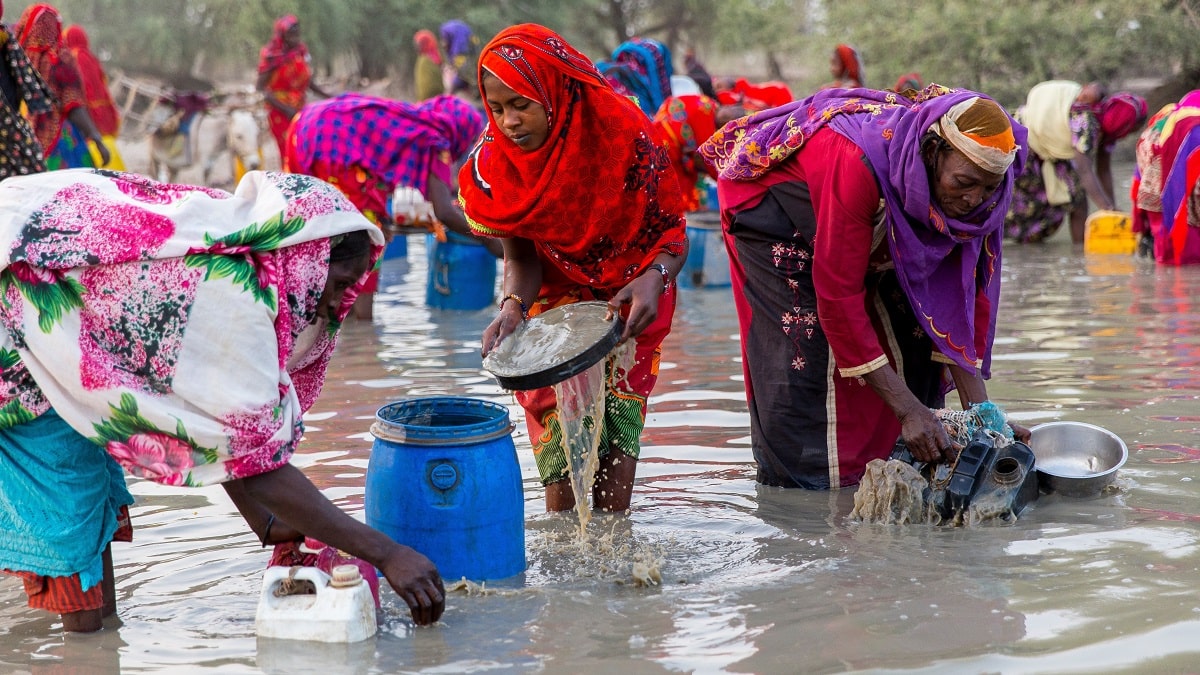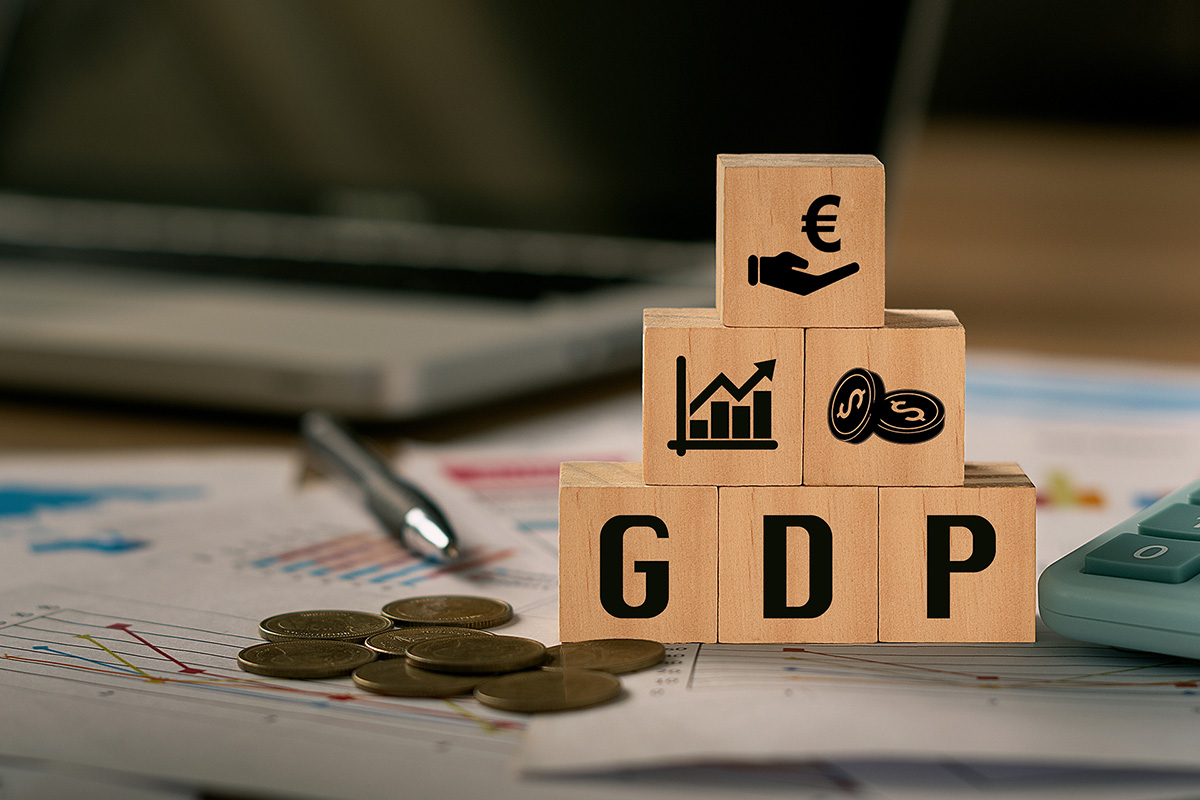

Finance
What Is The GDP Of Chad?
Published: October 29, 2023
(Many of the links in this article redirect to a specific reviewed product. Your purchase of these products through affiliate links helps to generate commission for LiveWell, at no extra cost. Learn more)
Table of Contents
- Introduction
- Overview of Chad’s Economy
- GDP Definition and Importance
- Chad’s GDP Growth and Trends
- Factors Affecting Chad’s GDP
- Primary Sectors Contributing to Chad’s GDP
- Secondary Sectors Contributing to Chad’s GDP
- Tertiary Sectors Contributing to Chad’s GDP
- Challenges and Opportunities for Chad’s GDP Growth
- Conclusion
Introduction
Chad, a landlocked country located in Central Africa, is one of the poorest nations in the world. With a population of over 15 million people and a sizeable portion living in poverty, Chad faces numerous economic challenges.
In order to understand the economic landscape of Chad, it is crucial to examine the country’s Gross Domestic Product (GDP). The GDP of Chad serves as an essential indicator of the country’s economic performance, reflecting the total market value of all goods and services produced within its borders.
Chad’s economy heavily relies on natural resources, including oil, agriculture, and livestock. However, the volatility of global oil prices, coupled with persistent issues such as political instability, infrastructural deficiencies, and limited access to education and healthcare, significantly impact Chad’s GDP growth.
Despite these challenges, Chad has shown some positive trends in recent years, primarily driven by increased oil production and efforts to diversify the economy. This article will delve into the factors influencing Chad’s GDP, the primary sectors contributing to its growth, and the challenges and opportunities that lie ahead for the country’s economic development.
By providing a comprehensive overview of Chad’s GDP, this article aims to shed light on the current state of the country’s economy and identify potential pathways for sustainable growth.
Overview of Chad’s Economy
Chad’s economy is primarily characterized by its dependency on oil revenues and agricultural activities. Oil extraction has been a significant driver of economic growth, contributing to a substantial portion of the country’s GDP. However, due to the unpredictable nature of oil prices in the global market, Chad’s economy is susceptible to fluctuations and external shocks.
Agriculture plays a crucial role in Chad’s economy, accounting for a significant portion of employment and contributing to food security and export opportunities. The country’s agricultural sector mainly focuses on subsistence farming, with crops such as cotton, peanuts, sorghum, and millet being cultivated by small-scale farmers.
In addition to oil and agriculture, Chad’s economy is also supported by other sectors, including livestock production, mining, and services. Livestock, including cattle, sheep, and goats, is of great importance as it provides a source of income and plays a significant role in cultural practices and social cohesion.
The mining sector in Chad is relatively underdeveloped, although the country is known to have deposits of various minerals, including gold, uranium, and limestone. Efforts are being made to attract foreign investment and promote sustainable mining practices to harness the potential of these resources.
The services sector in Chad is still in its nascent stages but has the potential for growth. Services such as telecommunications, banking, and tourism have started to gain traction in recent years, driven by an increasing urban population and improvements in infrastructure.
Chad’s economy is also influenced by factors such as political stability, governance, and social development. The government has been implementing reforms to improve the business environment, attract foreign investment, and diversify the economy away from oil dependency.
Despite the challenges faced by Chad’s economy, the government and various international organizations are working together to address issues such as poverty reduction, infrastructure development, and the promotion of inclusive growth.
GDP Definition and Importance
Gross Domestic Product (GDP) is a crucial measure used to evaluate the overall economic performance of a country. It represents the total market value of all final goods and services produced within a country’s borders during a specific period, usually a year.
GDP provides valuable insights into the size and growth rate of an economy. It serves as a key indicator of a country’s standard of living, economic productivity, and overall economic well-being. By analyzing GDP, policymakers, investors, and economists can gauge a nation’s economic health and make informed decisions.
Understanding the importance of GDP requires recognizing its role in several key areas:
- Economic Growth: GDP growth is a critical factor in assessing a country’s economic progress. Increasing GDP signifies that the economy is expanding, leading to higher levels of employment, income, and investment opportunities.
- Government Policy: Policymakers rely on GDP data to formulate and evaluate economic policies. By monitoring GDP growth, inflation rates, and other economic indicators, governments can make informed decisions regarding fiscal and monetary policies.
- International Comparison: GDP allows for comparisons between countries and regions, providing insights into economic disparities, competitiveness, and potential trade opportunities. It helps identify growth potential, investment attractiveness, and areas for improvement.
- Socioeconomic Development: GDP per capita, derived by dividing GDP by the population, provides a measure of average income and living standards. Higher GDP per capita suggests better access to education, healthcare, and infrastructure, contributing to overall socioeconomic development.
In the case of Chad, GDP serves as a vital metric for evaluating the country’s economic progress and identifying areas that require attention and investment. It helps measure the effectiveness of policies aimed at reducing poverty, improving infrastructure, and promoting sustainable economic growth.
It is important, however, to note that while GDP provides valuable insights into the overall economic activity, it does not account for factors such as income distribution, quality of life, environmental sustainability, and informal economic activities. Therefore, it is essential to complement GDP analysis with other indicators to obtain a holistic understanding of a country’s economic landscape.
Chad’s GDP Growth and Trends
Chad’s GDP growth has been largely influenced by the fluctuations in global oil prices and the country’s heavy reliance on oil revenues. Over the past decade, Chad has experienced both periods of rapid economic expansion and significant downturns.
From 2000 to 2014, Chad saw substantial GDP growth, with an average annual growth rate of around 8%. This period was largely driven by increased oil production and investment in infrastructure projects. However, with the global recession and a sharp decline in oil prices in 2014, Chad’s economy took a severe hit, leading to a contraction in GDP and challenges in fiscal management.
In recent years, Chad has shown signs of recovery and moderate GDP growth. The country’s GDP recorded a growth rate of 3.2% in 2019, followed by an estimated 3.5% in 2020. This growth has been attributed to efforts to diversify the economy, improve the business environment, and attract foreign investment in sectors beyond oil.
However, it is essential to recognize that Chad’s economic growth remains vulnerable to external shocks, especially those related to oil prices. The COVID-19 pandemic further exacerbated the challenges, with a decline in demand and prices for oil globally.
To address these issues and foster sustainable economic growth, the government has implemented various reforms. These include strengthening governance and transparency, improving infrastructure, promoting agriculture and rural development, and investing in education and healthcare sectors to enhance human capital.
Furthermore, the government has undertaken initiatives to diversify the economy and reduce its dependence on oil. This includes encouraging investment in sectors such as agriculture, mining, and services, fostering entrepreneurship, and promoting regional and international trade.
Despite the progress made, there are still significant challenges to overcome, including inadequate infrastructure, limited access to financial services, and the need for skilled labor. Additionally, political stability and security remain crucial for sustained economic growth and attracting foreign investment.
While Chad’s GDP growth has shown positive trends in recent years, the country needs to continue its efforts to diversify its economy, improve the business environment, and invest in human capital and infrastructure. These steps will help mitigate the vulnerability to oil price fluctuations and create a more resilient and inclusive economy for the people of Chad.
Factors Affecting Chad’s GDP
Several factors have a significant impact on Chad’s Gross Domestic Product (GDP). These factors encompass both internal and external influences that shape the country’s economic performance. Understanding these factors is crucial for devising strategies to promote sustainable and inclusive economic growth in Chad.
1. Oil Price Volatility: Chad heavily relies on oil revenues, and therefore, fluctuations in global oil prices have a direct impact on the country’s GDP. When oil prices are high, Chad experiences increased revenue, leading to economic growth. Conversely, when oil prices drop, the economy suffers, resulting in a decline in GDP.
2. Political Stability: Political stability is essential for a conducive business environment and attracting foreign investment. Chad has faced challenges related to political stability in the past, which has hindered its economic growth. Ensuring a stable political climate is vital for creating an environment that encourages private sector investment and stimulates economic activity.
3. Infrastructure Development: Inadequate infrastructure, including transportation networks, power supply, and telecommunications, poses a significant constraint on Chad’s economic growth. Improving infrastructure is crucial for enhancing productivity, attracting investments, and facilitating trade within the country and internationally.
4. Access to Education and Healthcare: Limited access to quality education and healthcare services hinders human capital development in Chad. Investing in education and healthcare is essential for improving the skills and productivity of the workforce, leading to greater economic output and long-term GDP growth.
5. Agricultural Productivity: Agriculture plays a crucial role in Chad’s economy, but low agricultural productivity limits its potential contribution to GDP. Encouraging sustainable agricultural practices, providing access to modern inputs and technology, and promoting value addition in the agriculture sector are key factors in boosting agricultural productivity and overall economic growth.
6. Economic Diversification: Chad’s heavy reliance on oil revenues makes the economy vulnerable to fluctuations in global oil prices. Therefore, diversifying the economy by promoting sectors such as agriculture, mining, manufacturing, and services is essential for reducing dependency on oil and creating a more resilient and balanced economy.
7. Regional and International Trade: Strengthening regional and international trade ties can open up new markets, increase foreign direct investment, and promote economic growth. Removing trade barriers, improving customs procedures, and participating in regional integration initiatives can enhance Chad’s access to markets and diversify its export base.
Addressing these factors requires a multi-faceted approach involving government policies, private sector participation, and international cooperation. By focusing on improving political stability, infrastructure development, education and healthcare access, agricultural productivity, economic diversification, and trade facilitation, Chad can create an enabling environment for sustainable economic growth and development.
Primary Sectors Contributing to Chad’s GDP
Chad’s economy is heavily reliant on several primary sectors that contribute significantly to the country’s Gross Domestic Product (GDP). These sectors play a crucial role in providing employment opportunities, income generation, and foreign exchange earnings. Understanding the primary sectors contributing to Chad’s GDP is essential for identifying areas of strength and potential for growth.
1. Oil: The oil sector is the primary driver of Chad’s economy and has been a significant source of revenue for the country. Chad is an oil-producing nation, with oil extraction and refining accounting for a substantial portion of its GDP. Oil exports play a crucial role in generating foreign exchange earnings and stimulating economic growth.
2. Agriculture: Agriculture is a vital sector that contributes significantly to Chad’s GDP and provides employment for a large portion of the population. The country’s agricultural activities primarily focus on subsistence farming, with crops such as cotton, peanuts, sorghum, and millet being cultivated. Agriculture also supports other sectors, such as textile manufacturing and food processing, further contributing to GDP growth.
3. Livestock: Livestock production is another important primary sector in Chad’s economy. Cattle, sheep, and goats are reared for meat, milk, and hides, serving as a source of income and sustenance for many Chadians. Livestock farming plays a significant role in supporting rural livelihoods, providing employment opportunities, and contributing to GDP growth.
4. Mining: Chad possesses significant mineral resources, including gold, uranium, limestone, and other valuable minerals. While the mining sector is relatively underdeveloped, efforts are being made to attract foreign investment and promote sustainable mining practices. The exploration and extraction of these minerals have the potential to contribute to Chad’s GDP and stimulate economic growth in the long run.
While these primary sectors currently contribute to Chad’s GDP, it is important for the country to diversify its economy and reduce its dependence on oil. Efforts are being made to promote sectors such as agriculture, mining, and services to foster economic diversification and create a more balanced and resilient economy.
By strengthening infrastructure, improving access to education and healthcare, fostering innovation, and supporting small-scale farmers and livestock breeders, Chad can tap into the full potential of these primary sectors and develop a sustainable and inclusive economy.
Secondary Sectors Contributing to Chad’s GDP
In addition to the primary sectors, Chad’s economy is supported by various secondary sectors that contribute significantly to the country’s Gross Domestic Product (GDP). These sectors involve industrial activities, manufacturing, and processing of raw materials, adding value to the country’s resources and driving economic growth. Understanding the secondary sectors contributing to Chad’s GDP provides insights into the country’s industrial development and potential for further expansion.
1. Refining and Petroleum Products: Chad’s oil production is complemented by the refining and processing of petroleum products. While the refining capacity is limited, efforts are being made to expand and modernize the downstream oil industry. This sector contributes to GDP through the production of refined petroleum products, such as gasoline, diesel, and liquefied petroleum gas (LPG).
2. Textile and Garments: The textile and garments sector plays a significant role in Chad’s economy. Cotton, one of the main agricultural crops, serves as the primary raw material for textile manufacturing. The sector involves spinning, weaving, and garment production, providing employment opportunities and generating export revenue.
3. Food Processing: Food processing is an important secondary sector in Chad, contributing to both domestic consumption and export. The sector involves the processing and preservation of agricultural products, including cereals, fruits, vegetables, and livestock products. Processed food products, such as oils, flour, canned goods, and dairy products, add value to agricultural output and contribute to GDP.
4. Construction and Infrastructure: The construction sector plays a crucial role in infrastructure development and contributes to Chad’s GDP. The construction industry encompasses the building of roads, bridges, schools, hospitals, housing, and other infrastructure projects. Infrastructure development is vital for stimulating economic growth, attracting investments, and improving the overall quality of life for the population.
5. Manufacturing: While manufacturing activities in Chad are relatively limited, there are efforts to promote and expand this sector. Manufacturing includes activities such as the production of consumer goods, furniture, construction materials, and small-scale industries. The expansion of the manufacturing sector can contribute to job creation, value addition, and economic diversification.
6. Energy Production: Apart from petroleum-related activities, Chad has the potential for harnessing other sources of energy, such as solar and wind power. Initiatives are being undertaken to promote renewable energy projects, which can contribute to the country’s energy independence, reduce reliance on fossil fuels, and stimulate economic growth in the energy sector.
By focusing on strengthening these secondary sectors, Chad can further enhance its industrial capabilities, create employment opportunities, and stimulate economic growth. The development of these sectors requires supportive policies, access to financing, advancements in technology and innovation, and investment in human capital.
Tertiary Sectors Contributing to Chad’s GDP
The tertiary sector, also known as the services sector, plays a crucial role in contributing to Chad’s Gross Domestic Product (GDP). This sector encompasses a wide range of services and activities that support economic growth, employment, and the overall development of the country. Understanding the tertiary sectors contributing to Chad’s GDP provides insights into the diversification of the economy and potential areas for further expansion.
1. Telecommunications: The telecommunications sector has experienced significant growth in Chad, driven by advancements in technology and increased access to mobile phones and the internet. Mobile network operators play a crucial role in providing telecommunications services, expanding connectivity, and facilitating communication and information exchange across the country.
2. Banking and Financial Services: The banking and financial services sector supports economic activities by providing access to financial products and services, such as credit, savings, investment, and insurance. The sector facilitates transactions, mobilizes savings, and enables businesses to secure the necessary capital for growth and investment.
3. Tourism: Chad has immense potential for tourism, with its diverse landscapes, cultural heritage, and wildlife. The tourism sector contributes to GDP through activities such as hospitality, travel agencies, tour operators, and related services. Efforts are being made to develop and promote tourism, improve infrastructure, and preserve natural and cultural heritage sites.
4. Transportation and Logistics: The transportation and logistics sector plays a vital role in connecting different regions of Chad and facilitating the movement of goods and people. This sector includes road transport, aviation, shipping, and warehousing services. Improvements in transportation infrastructure support trade, enhance connectivity, and contribute to economic development.
5. Healthcare Services: The healthcare sector plays a critical role in promoting well-being, addressing health challenges, and supporting social development. Healthcare services include hospitals, clinics, pharmaceuticals, medical professionals, and other related services. Investments in healthcare infrastructure and human resources are essential for improving access to quality healthcare and enhancing the overall health indicators in Chad.
6. Educational Services: The education sector contributes to human capital development, skills enhancement, and knowledge creation. Educational services encompass primary, secondary, and higher education institutions, vocational training centers, and research institutions. Investments in education are crucial for cultivating a skilled workforce, promoting innovation, and driving economic growth.
7. Professional Services: Professional services, including legal, accounting, consulting, engineering, and other professional occupations, contribute to economic growth by providing specialized expertise and support to businesses and organizations. This sector helps in improving business operations, facilitating legal compliance, and promoting efficient management practices.
The growth and development of these tertiary sectors can help diversify Chad’s economy, reduce dependency on primary sectors, and create employment opportunities. However, it is essential to address challenges such as limited access to quality services, skill gaps, and infrastructure deficiencies to unlock the full potential of the tertiary sector in contributing to Chad’s GDP.
Challenges and Opportunities for Chad’s GDP Growth
Chad faces several challenges on its path to achieving sustained and inclusive GDP growth. However, amidst these challenges, there are also opportunities that can be leveraged to foster economic development and improve the well-being of its population.
Challenges:
- Oil Price Volatility: Chad’s heavy reliance on oil revenues makes the economy vulnerable to fluctuations in global oil prices. Oil price volatility can have a significant impact on the country’s GDP growth and fiscal stability.
- Infrastructure Deficiencies: Inadequate infrastructure, including transportation networks, power supply, and telecommunications, poses a significant constraint on economic growth. Insufficient infrastructure inhibits trade, hinders investment, and limits the efficient operation of businesses.
- Political Instability: Political instability has been a recurring challenge in Chad. Political unrest and conflicts impact investor confidence, hinder domestic and foreign investments, and disrupt economic activities.
- Limited Access to Education and Healthcare: Insufficient access to quality education and healthcare services hinders human capital development and productivity in Chad. This creates a barrier to economic growth and exacerbates social inequalities.
- Dependency on Primary Sectors: Chad’s heavy reliance on primary sectors, particularly oil and agriculture, exposes the economy to external shocks and price fluctuations. Over-dependence on these sectors limits diversification and poses risks to sustainable GDP growth.
Opportunities:
- Focus on Economic Diversification: Chad has the opportunity to diversify its economy beyond oil and develop sectors such as agriculture, mining, services, and tourism. Promoting entrepreneurship, innovation, and attracting foreign investments can help create new employment opportunities and reduce dependency on primary sectors.
- Investment in Infrastructure: Addressing infrastructure deficiencies by investing in transportation, energy, and telecommunications can improve connectivity, facilitate trade, and attract investments. Enhancing infrastructure will lay the foundation for economic growth and create an enabling environment for businesses.
- Regional Integration: Chad can leverage its strategic location in Central Africa to participate in regional integration initiatives. Strengthening regional cooperation, reducing trade barriers, and promoting cross-border investments can expand market access, increase trade volumes, and drive economic growth.
- Promoting Human Capital Development: Ensuring access to quality education and healthcare services is crucial for human capital development in Chad. Investing in education and healthcare infrastructure, improving curriculum quality, and enhancing skills training programs can enhance productivity, innovation, and long-term economic growth.
- Enhancing Governance and Institutional Framework: Strengthening governance, accountability, and transparency in Chad is imperative to create a favorable business environment and attract investments. Implementing reforms to improve the ease of doing business, enhance the rule of law, and combat corruption will instill investor confidence and promote economic growth.
Addressing these challenges and seizing the opportunities will require coordinated efforts from the government, private sector, and international partners. By implementing sound economic policies, investing in human capital, diversifying the economy, and improving infrastructure, Chad can unlock its potential for sustainable GDP growth and create a brighter future for its people.
Conclusion
Chad’s Gross Domestic Product (GDP) serves as a crucial indicator of the country’s economic performance and reflects its progress in achieving sustainable and inclusive growth. Although Chad faces various challenges, including the volatility of global oil prices, political instability, and limited access to education and healthcare, there are also opportunities to foster GDP growth and improve the well-being of its population.
The diversification of the economy beyond oil, the development of sectors such as agriculture, mining, services, and tourism, and the improvement of infrastructure are key opportunities for Chad. By promoting economic diversification, Chad can reduce its dependence on oil and create a more resilient and balanced economy that offers new employment opportunities and stimulates innovation.
Investing in infrastructure, including transportation, energy, and telecommunications, is crucial for facilitating trade, attracting investments, and improving connectivity within Chad and with regional partners. Furthermore, focusing on human capital development by ensuring access to quality education and healthcare services will enhance productivity, innovation, and long-term economic growth.
Despite the challenges faced by Chad, the government’s commitment to reforms, along with international support, provides the foundation for sustainable economic development. By strengthening governance, enhancing the business environment, and promoting transparency, Chad can attract foreign investments and foster a vibrant private sector.
It is important to remember that sustainable GDP growth should not be pursued at the expense of social and environmental considerations. It is crucial to balance economic development with social inclusion, environmental sustainability, and the preservation of natural resources and cultural heritage.
In conclusion, Chad has significant potential to achieve sustained and inclusive GDP growth. By diversifying the economy, improving infrastructure, investing in human capital, and strengthening governance, Chad can overcome its challenges and create an environment that promotes economic opportunities and improves the well-being of its people.














